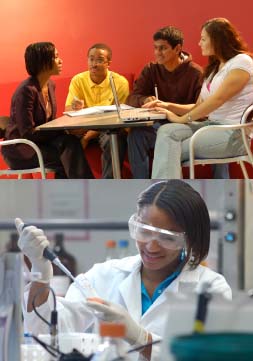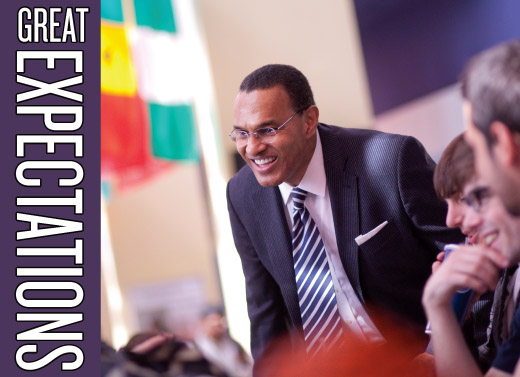Great Expectations
Freeman Hrabowski knows how students can succeed in STEM – and makes sure they do.
It’s not easy to remain a mere face in the crowd at the University of Maryland Baltimore County. Freeman A. Hrabowski III, the president of this 13,000-student school on the edge of Baltimore, is known for his impressive recall of student names. On daily walks across the red-brick campus, he greets students by name – introducing himself to those he hasn’t yet met – and asks what they’re working on or how they did on a recent test. “He just knows the path so many of the students have taken,” says Warren DeVries, dean of UMBC’s College of Engineering and Information Technology. “He seems to have everybody’s curriculum and progress in the back of his mind.”
That kind of personal attention is a big part of UMBC’s culture, which Hrabowski describes as “inclusive excellence.” The combination of making people feel welcome and supported, while setting high expectations that they will both produce good work and be able to communicate clearly about it — has put UMBC on the map, as have its strength in undergraduate teaching and record of graduating students, particularly minorities, in the STEM fields. The school’s success is particularly relevant now amid a White House-led drive to improve undergraduate retention in science and engineering.
“He’s always pushing us to be able to talk about what we did,” says Malcolm Taylor, who graduated in 2008 with a bachelor’s in computer engineering and is now in his third year pursuing a Ph.D. in electrical and computer engineering at Carnegie Mellon University. “If he’s with someone, he’ll say (to a student), ‘Tell him what you’re doing.’”
Taylor, a recent National Science Foundation Graduate Research Fellowship winner who is working with GM on safe and secure hardware systems for cars, says he chose UMBC over other universities because of the community and support system it offered. Taylor was a member of the Meyerhoff Scholars Program, a signature UMBC initiative focused on helping high-achieving students, especially minorities, become leaders in science and engineering by preparing them to earn Ph.D.’s in the STEM fields.
The program was launched in 1988 by Hrabowski – then vice provost – with a half-million dollars in seed money from Baltimore philanthropists Robert and Jane Meyerhoff to support African-American men committed to achieving Ph.D.’s in science, engineering, and math. Its graduates have gone on to earn, collectively, 81 Ph.D.’s, 25 M.D./Ph.D. degrees, and 92 M.D.’s. Expanded to include women in 1990 and all races in 1996, its 2010-11 roster of 230 students was 51 percent African-American. Nearly 300 of its 700 graduates are currently enrolled in a graduate or professional degree program. The school boasts that Meyerhoff scholars were five times as likely to pursue STEM Ph.D.’s as students who were offered a spot in the program but attended college elsewhere. UMBC, where 45 percent of students are STEM majors, has seen the highest number of African-American graduates go on to Ph.D.’s in STEM fields of any predominantly white institution.
The Meyerhoff program had already brought accolades to Hrabowski and UMBC when Prism profiled him in 2002. These included a U.S. Presidential Award for Excellence in Science, Mathematics, and Engineering Mentoring in 1996 and the Harold W. McGraw Jr. Prize in Education in 2001. That the tributes keep coming is a measure not just of his success but also of America’s persistent problem of educating underrepresented minorities in the STEM fields. Last year, Hrabowski was awarded the Carnegie Corp.’s Centennial Academic Leadership Award, as well as the “Top American Leader” award from the Washington Post and Harvard University. He was profiled on 60 Minutes, and Time named him one of the Top 10 College Presidents. In December, he was one of 12 college leaders who met with President Obama to discuss college affordability.
The 61-year-old Hrabowski jokes that the accumulating awards just means he’s getting old. He deflects credit to the students, faculty, and staff of UMBC. “All I’m doing is telling their stories,” he says. “This is a place not short on inspiration.”

Meyerhoff scholars with adviser (top) and in labs
A Young Achiever
Nor, for that matter, is Hrabowski. Descended from rural Alabama slaves and a Polish slave master, from whom he got his surname, Hrabowski grew up amid the civil rights struggle in Birmingham. When he was 12, he joined in Martin Luther King Jr.’s “Children’s March” and spent five days in jail. An only child whose mother was an English teacher, he relished academic challenges; he recalls getting “goose bumps” when solving word problems. He entered the Hampton Institute, now Hampton University, at 15, graduating with a degree in math at 19. At 24, he had earned a master’s in math and a Ph.D. in higher education administration and statistics from the University of Illinois at Urbana-Champaign.
Hrabowski became president of UMBC in 1992, and has served more than a decade longer than the average for college presidents. Diane Auer Jones, a former U.S. assistant secretary for postsecondary education and UMBC grad who considers Hrabowski a mentor and friend, says he could have left many times for bigger-name institutions and for presidencies with higher salaries. “He has really stuck with his project,” she says.
The Meyerhoff Scholars Program focuses on building a sense of community and family among the scholars (this year, there are 70 freshmen) while providing them financial, academic, and social support. Students get involved in research with faculty members and with companies in the UMBC research park, which prepares them for graduate school and shows early on what kind of careers are possible in science and engineering fields.
A six-week summer “bridge” program helps the scholars bond and introduces them to the expectations of college work from the get-go. Some unique aspects make it seem more like boot camp than summer school (the Meyerhoff program director is a Virginia Military Institute grad). Students go from 7 a.m. to midnight with no free time. They can’t use cellphones or personal computers, and must move from place to place as one group.
‘A Big Difference’
Rather than compete with one another, the scholars are expected to collaborate. They seek each other’s help for study groups, especially when coursework gets challenging. They also offer encouragement and a network of like-minded people on campus pursing similar goals.
The all-Meyerhoff meetings at the beginning and end of the semester are called family meetings, and in this 230-person family, everyone is known by name. That’s because, by the end of the summer bridge program, all of the scholars must stand up and say the name of everyone in their 60-plus person cohort.
“It’s something simple, but it makes a big difference,” says Taylor, the Carnegie Mellon Ph.D. candidate. “If you know everybody’s name, you’re not afraid to say hello. It forces you to come out of your shell and talk to people. It’s hard to forget somebody’s name if you’ve had a meaningful interaction with them.”
A data-driven decision maker, Hrabowski made sure the Meyerhoff program always had a research director. As a result, UMBC has two decades worth of data on the program’s best practices, which it shares with other colleges and uses to improve academics on its own campus, says LaMont Toliver, the Meyerhoff program director.
One thing UMBC has learned is that the No. 1 reason people drop out of STEM fields is they didn’t do well in the coursework. So UMBC is changing how courses are taught. Based on best practices from the Meyerhoff program, UMBC is now in the middle of major course redesigns in STEM and other areas to help build community among students, demand active engagement from faculty members, and involve students in research. In engineering, for example, a revamped introductory course has students doing industrial design projects in teams. Besides contributing to the nation’s workforce, gains in student success will benefit UMBC’s bottom line: Each time a student needs to retake an introductory class, it costs the university $1,600.
“It’s clear to us, if we can help students succeed … in the first two years of work, the student will remain in science and engineering, at least through the bachelor level,” Hrabowski says. Holding his iPhone, he shows a video of a redesigned first-year chemistry class. Students are scattered around a room in tables of four, talking and writing on whiteboards. “It’s loud, it’s collaborative, it’s engagement,” he says. “Everybody has a role. Somebody’s project manager, somebody’s serving as a scribe, somebody’s the provocateur, and they change roles throughout the semester.”
No one can sit in the back of this class. All students must talk about their work, and an individual’s grade is partly dependent on the others in the group. A sign at the front of the class that divides up team duties declares: “Learning Is Your Responsibility.”
The collaboration has carried over into the library, where individual carrels have been replaced at the students’ request with group study tables and booths, plus whiteboards that can be rolled around the room. To Hrabowski, this is what college life should be all about: “At UMBC the party is in the library.”
Kathryn Masterson is a freelance writer based in Washington, D.C.
UMBC’s Guide to What Works
- Widen the pool of faculty candidates to increase diversity and provide students with role models who look like them.
- Partner with business and industry to create research opportunities for faculty and students; offer summer research possibilities.
- Encourage study groups and tutoring.
- Provide personal advising and counseling.
- Link students with professional mentors in their field.
- Enlist faculty as mentors and advisers.
- Expect everyone to share responsibility for helping minority students graduate.
- Encourage student “ownership” of their program, engaging older students in interviewing younger applicants.
- Make clear what students should expect and what’s expected of them.
Category: Features
